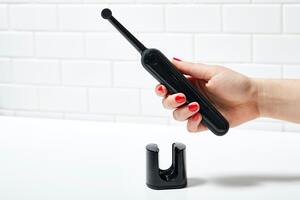You already understand the importance of having a great at-home oral health routine. You know that brushing twice daily is recommended. But with so many different kinds and designs of toothbrushes on the market these days, it can be tough to know which options are best. If you’re on the fence about changing toothbrushes, these are tips about manual versus electric toothbrushes you need to see.
Brushing With a Manual Toothbrush 

With a manual toothbrush, begin with the outer and inner surfaces, angling your brush at 45 degrees to ensure you reach the back teeth. Work your way to the area where you chew and hold the brush flat. Simply brush back and forth. When brushing the inside of your front teeth, tilt the brush vertically and brush gently up and down with the brush tip. Gently brush along the gum line too. And finally, brush your tongue from back to front, removing any food particles and keeping your breath minty fresh.
Pros of a Manual Toothbrush
Cheaper
One of the main reasons patients choose a manual toothbrush is because of the price. Manual toothbrushes are cheaper than electric versions.
Better Gum Care
By using a manual toothbrush, the patient has more control over the pressure they apply when brushing their teeth, preventing damage to receding gums or tooth enamel. Be mindful, however, not to apply too much pressure, which can be damaging to your gums.
Ideal for Travel
Packing a manual toothbrush is much easier than electric versions, as it needs no battery and takes up less space.
Brushing With an Electric Toothbrush
The same methods apply to using an electric toothbrush as it does for a manual. However, this time, when you hold the toothbrush at a 45-degree angle, you’re going to hold it there for 3-5 seconds for every tooth. The vibrations will assist in breaking up tartar. Start at the back of your upper teeth and brush the outside over to the opposite side of your mouth. Apply the brush under your back teeth from here and repeat from the inside. Once the top teeth are done, move to the lower teeth and follow the same process as above.
Pros of an Electric Toothbrush
Better Technology
Some electric toothbrushes have timers that help you brush your teeth for the ideal periods of time. Others have pressure sensors that trigger should you brush your teeth too hard. And certain brands promote sonic technology to break up plaque.
Less Waste
Toothbrushes should be renewed every three months. But only the head of an electric toothbrush needs to be replaced, reducing waste.
Better for Limited Mobility
Patients who struggle with limited mobility will find electric toothbrushes easier to use. The electric toothbrushes do most of the work for them.
What’s Best For You?
If you want to find out what toothbrush works best for you, speak to DeSanti & Linden Dentistry at your next appointment and learn more.